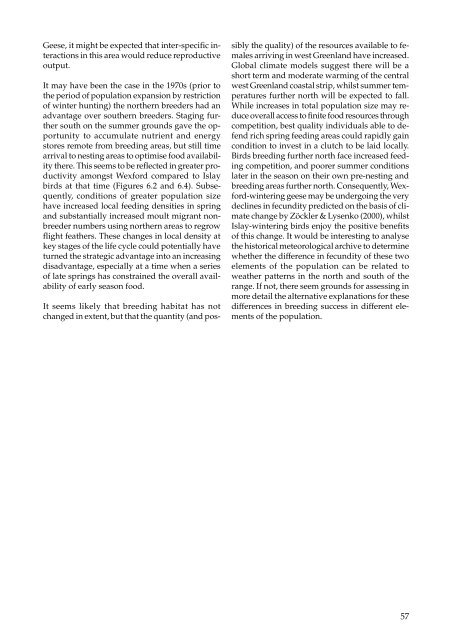The Greenland White-fronted Goose Anser albifrons flavirostris
The Greenland White-fronted Goose Anser albifrons flavirostris
The Greenland White-fronted Goose Anser albifrons flavirostris
Create successful ePaper yourself
Turn your PDF publications into a flip-book with our unique Google optimized e-Paper software.
Geese, it might be expected that inter-specific interactions<br />
in this area would reduce reproductive<br />
output.<br />
It may have been the case in the 1970s (prior to<br />
the period of population expansion by restriction<br />
of winter hunting) the northern breeders had an<br />
advantage over southern breeders. Staging further<br />
south on the summer grounds gave the opportunity<br />
to accumulate nutrient and energy<br />
stores remote from breeding areas, but still time<br />
arrival to nesting areas to optimise food availability<br />
there. This seems to be reflected in greater productivity<br />
amongst Wexford compared to Islay<br />
birds at that time (Figures 6.2 and 6.4). Subsequently,<br />
conditions of greater population size<br />
have increased local feeding densities in spring<br />
and substantially increased moult migrant nonbreeder<br />
numbers using northern areas to regrow<br />
flight feathers. <strong>The</strong>se changes in local density at<br />
key stages of the life cycle could potentially have<br />
turned the strategic advantage into an increasing<br />
disadvantage, especially at a time when a series<br />
of late springs has constrained the overall availability<br />
of early season food.<br />
It seems likely that breeding habitat has not<br />
changed in extent, but that the quantity (and pos-<br />
sibly the quality) of the resources available to females<br />
arriving in west <strong>Greenland</strong> have increased.<br />
Global climate models suggest there will be a<br />
short term and moderate warming of the central<br />
west <strong>Greenland</strong> coastal strip, whilst summer temperatures<br />
further north will be expected to fall.<br />
While increases in total population size may reduce<br />
overall access to finite food resources through<br />
competition, best quality individuals able to defend<br />
rich spring feeding areas could rapidly gain<br />
condition to invest in a clutch to be laid locally.<br />
Birds breeding further north face increased feeding<br />
competition, and poorer summer conditions<br />
later in the season on their own pre-nesting and<br />
breeding areas further north. Consequently, Wexford-wintering<br />
geese may be undergoing the very<br />
declines in fecundity predicted on the basis of climate<br />
change by Zöckler & Lysenko (2000), whilst<br />
Islay-wintering birds enjoy the positive benefits<br />
of this change. It would be interesting to analyse<br />
the historical meteorological archive to determine<br />
whether the difference in fecundity of these two<br />
elements of the population can be related to<br />
weather patterns in the north and south of the<br />
range. If not, there seem grounds for assessing in<br />
more detail the alternative explanations for these<br />
differences in breeding success in different elements<br />
of the population.<br />
57


